LOTUS ELISE 2005 Owners Manual
Manufacturer: LOTUS, Model Year: 2005, Model line: ELISE, Model: LOTUS ELISE 2005Pages: 205, PDF Size: 4.51 MB
Page 111 of 205

Washer ReservoirThe windscreen washer reservoir is situated at the left hand
rear of the engine bay, and should be kept topped up with clean
water and a suitable proprietary solvent.
NOTICE:
Do NOT use radiator antifreeze in the reservoir as
this could seriously damage the paintwork and/or some plastic components.
The washer jets are mounted each side of the wiper spindle,
and may, if necessary, be cleared or adjusted using a suitable pin.
Wiper Blade To replace the single wiper blade, lift the arm away from the
‘screen, swing the blade through 90°, depress the retaining tab and slide the blade down the arm to unhook and release.
When refitting, ensure that the retaining clip is re-engaged
in the wiper arm slot.
ohs36a
ohs130
WASHER RESERVOIR CAPWIPER BLADE FITMENT
Servicing & Maintenance
109
Retaining tab
Wiper arm
oh_croft_InD.indd 10920/05/2004 07:59:08ProCarManuals.com
Page 112 of 205
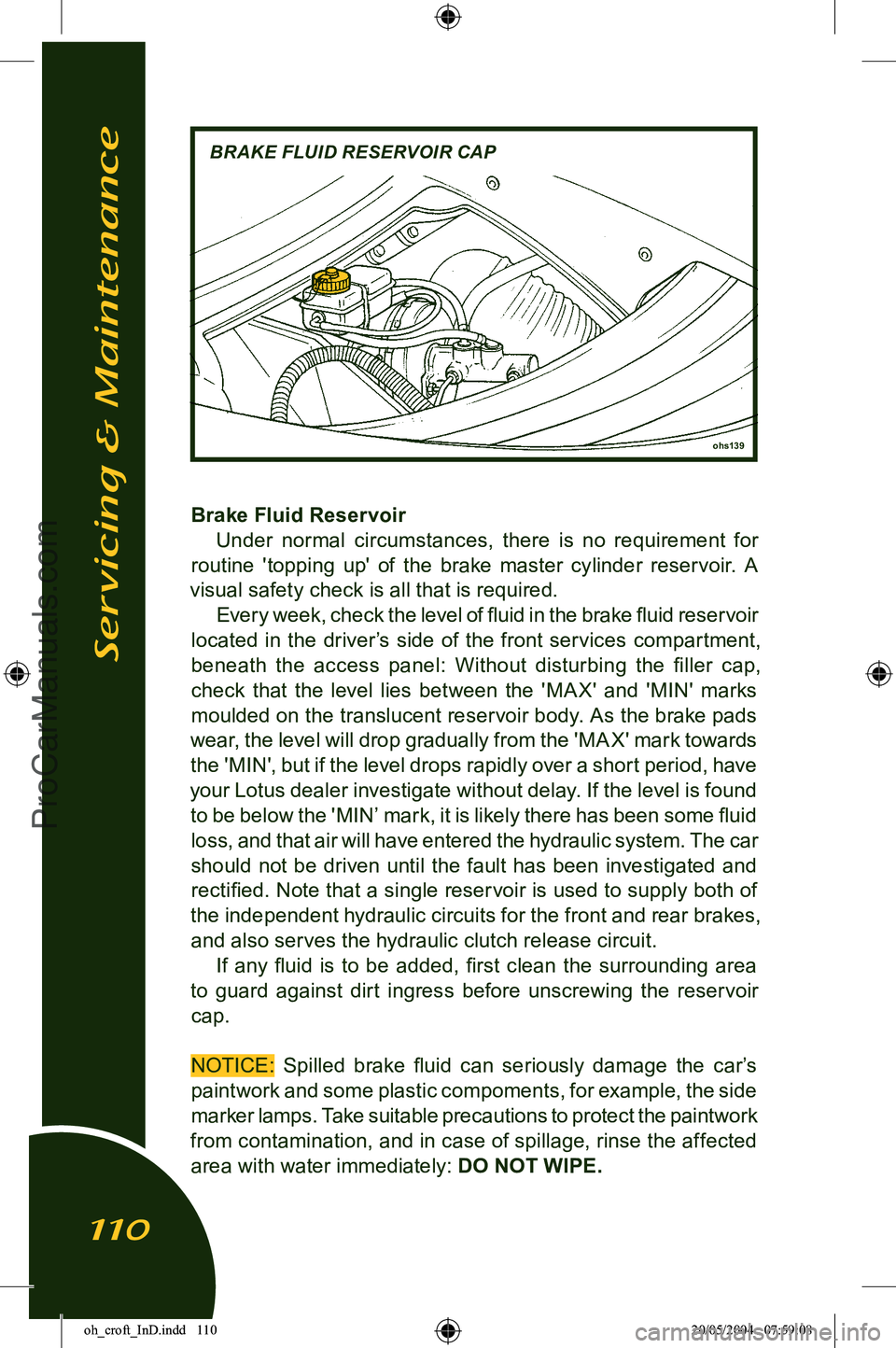
Brake Fluid ReservoirUnder normal circumstances, there is no requirement for
routine 'topping up' of the brake master cylinder reservoir. A
visual safety check is all that is required. Every week, check the level of fluid in the brake fluid reservoir
located in the driver’s side of the front services compartment, beneath the access panel: Without disturbing the filler cap,
check that the level lies between the 'MA X' and 'MIN' marks moulded on the translucent reservoir body. As the brake pads
wear, the level will drop gradually from the 'MA X' mark towards the 'MIN', but if the level drops rapidly over a short period, have
your Lotus dealer investigate without delay. If the level is found
to be below the 'MIN’ mark, it is likely there has been some fluid loss, and that air will have entered the hydraulic system. The car
should not be driven until the fault has been investigated and rectified. Note that a single reservoir is used to supply both of
the independent hydraulic circuits for the front and rear brakes, and also serves the hydraulic clutch release circuit. If any fluid is to be added, first clean the surrounding area
to guard against dirt ingress before unscrewing the reservoir cap.
NOTICE: Spilled brake fluid can seriously damage the car’s paintwork and some plastic compoments, for example, the side
marker lamps. Take suitable precautions to protect the paintwork
from contamination, and in case of spillage, rinse the affected area with water immediately: DO NOT WIPE.
ohs139
BRAKE FLUID RESERVOIR CAP
Servicing & Maintenance
110
oh_croft_InD.indd 11020/05/2004 07:59:08ProCarManuals.com
Page 113 of 205
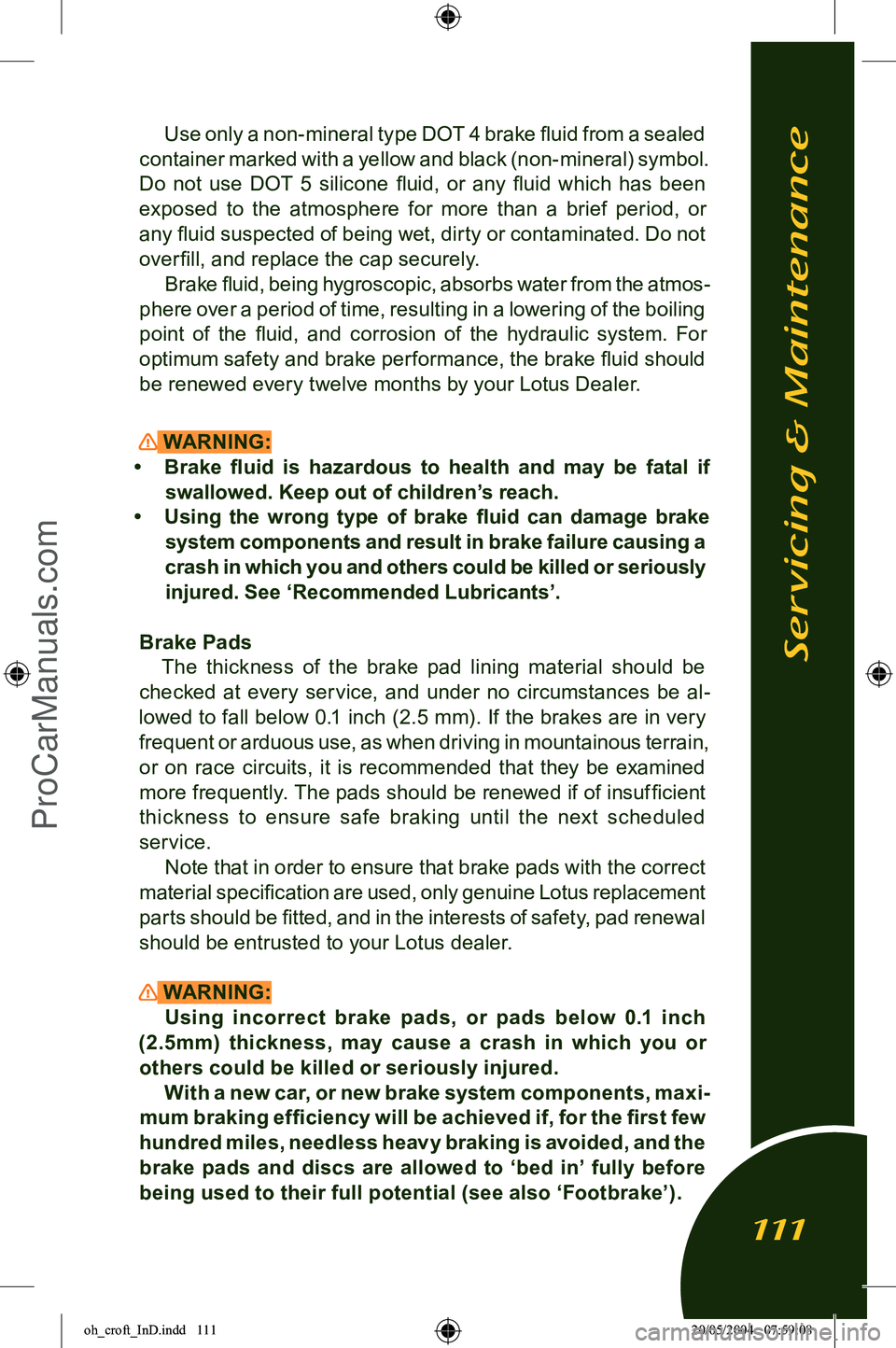
Use only a non-mineral type DOT 4 brake fluid from a sealed
container marked with a yellow and black (non-mineral) symbol.
Do not use DOT 5 silicone fluid, or any fluid which has been
exposed to the atmosphere for more than a brief period, or
any fluid suspected of being wet, dirty or contaminated. Do not over fill, and replace the cap securely. Brake fluid, being hygroscopic, absorbs water from the atmos
-
phere over a period of time, resulting in a lowering of the boiling
point of the fluid, and corrosion of the hydraulic system. For
optimum safety and brake performance, the brake fluid should be renewed every twelve months by your Lotus Dealer.
WARNING:
• Brake fluid is hazardous to health and may be fatal if swallowed. Keep out of children’s reach.
• Using the wrong type of brake fluid can damage brake system components and result in brake failure causing a
crash in which you and others could be killed or seriously
injured. See ‘Recommended Lubricants’.
Brake Pads The thickness of the brake pad lining material should be
checked at every service, and under no circumstances be al
-
lowed to fall below 0.1 inch (2.5 mm). If the brakes are in very frequent or arduous use, as when driving in mountainous terrain,
or on race circuits, it is recommended that they be examined
more frequently. The pads should be renewed if of insufficient
thickness to ensure safe braking until the next scheduled service.
Note that in order to ensure that brake pads with the correct
material specification are used, only genuine Lotus replacement parts should be fitted, and in the interests of safety, pad renewal
should be entrusted to your Lotus dealer.
WARNING: Using incorrect brake pads, or pads below 0.1 inch
(2.5mm) thickness, may cause a crash in which you or
others could be killed or seriously injured. With a new car, or new brake system components, maxi
-
mum braking efficiency will be achieved if, for the first few
hundred miles, needless heavy braking is avoided, and the
brake pads and discs are allowed to ‘bed in’ fully before
being used to their full potential (see also ‘Footbrake’).
Servicing & Maintenance
111
oh_croft_InD.indd 11120/05/2004 07:59:08ProCarManuals.com
Page 114 of 205

Brake Pipes & HosesAt the recommended service intervals, the brake pipes and
flexible hoses should be carefully examined for signs of dam
-
age, corrosion or perishing, especially in territories where salt is used on the road surface in the winter months.
Servicing & Maintenance
112
oh_croft_InD.indd 11220/05/2004 07:59:08ProCarManuals.com
Page 115 of 205
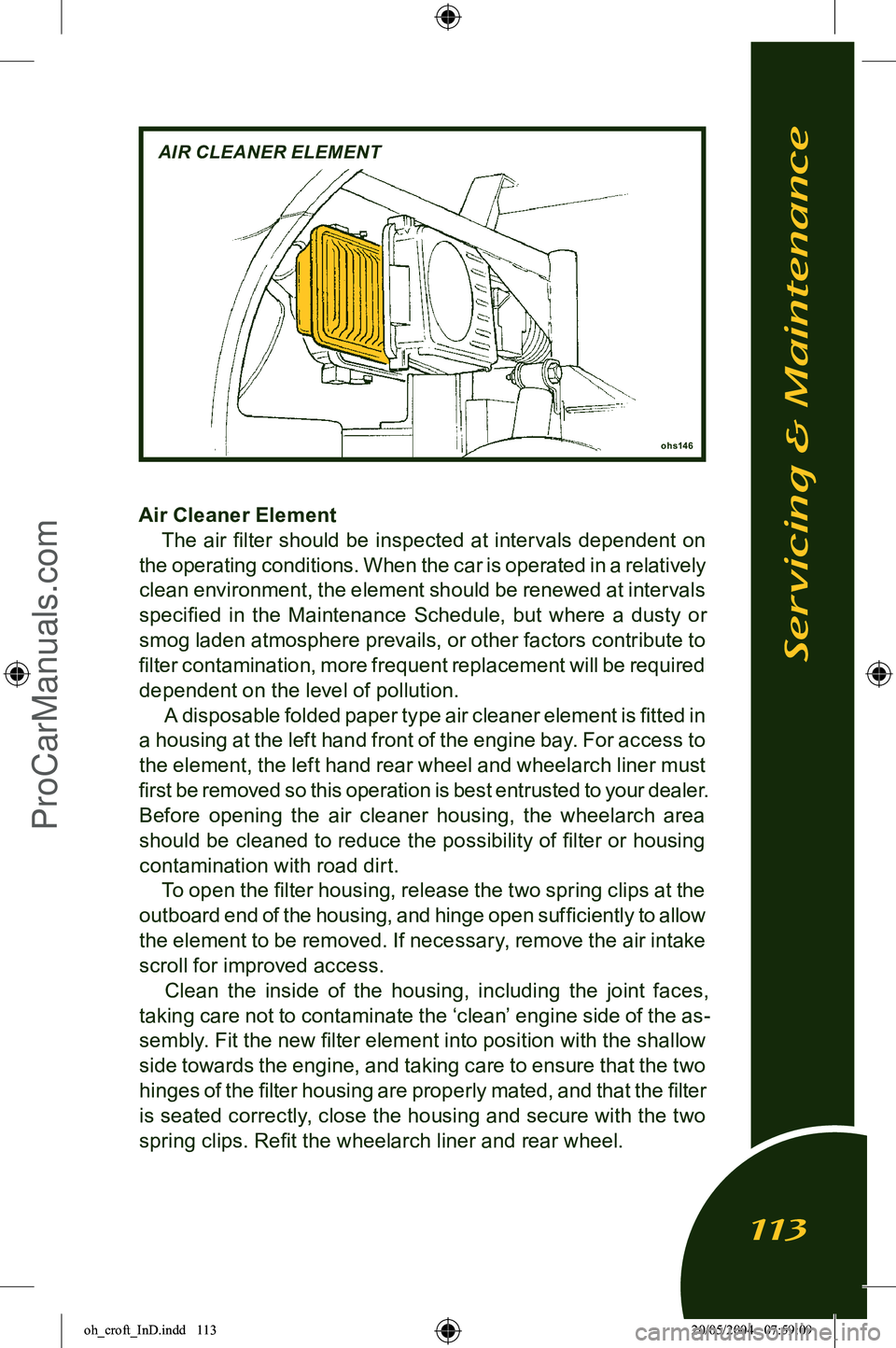
Air Cleaner ElementThe air filter should be inspected at intervals dependent on
the operating conditions. When the car is operated in a relatively
clean environment, the element should be renewed at intervals
specified in the Maintenance Schedule, but where a dusty or
smog laden atmosphere prevails, or other factors contribute to
filter contamination, more frequent replacement will be required
dependent on the level of pollution. A disposable folded paper type air cleaner element is fitted in
a housing at the left hand front of the engine bay. For access to
the element, the left hand rear wheel and wheelarch liner must
first be removed so this operation is best entrusted to your dealer.
Before opening the air cleaner housing, the wheelarch area
should be cleaned to reduce the possibility of filter or housing contamination with road dirt. To open the filter housing, release the two spring clips at the
outboard end of the housing, and hinge open sufficiently to allow
the element to be removed. If necessary, remove the air intake scroll for improved access. Clean the inside of the housing, including the joint faces,
taking care not to contaminate the ‘clean’ engine side of the as
-
sembly. Fit the new filter element into position with the shallow
side towards the engine, and taking care to ensure that the two
hinges of the filter housing are properly mated, and that the filter
is seated correctly, close the housing and secure with the two
spring clips. Refit the wheelarch liner and rear wheel.
ohs146
AIR CLEANER ELEMENT
Servicing & Maintenance
113
oh_croft_InD.indd 11320/05/2004 07:59:09ProCarManuals.com
Page 116 of 205
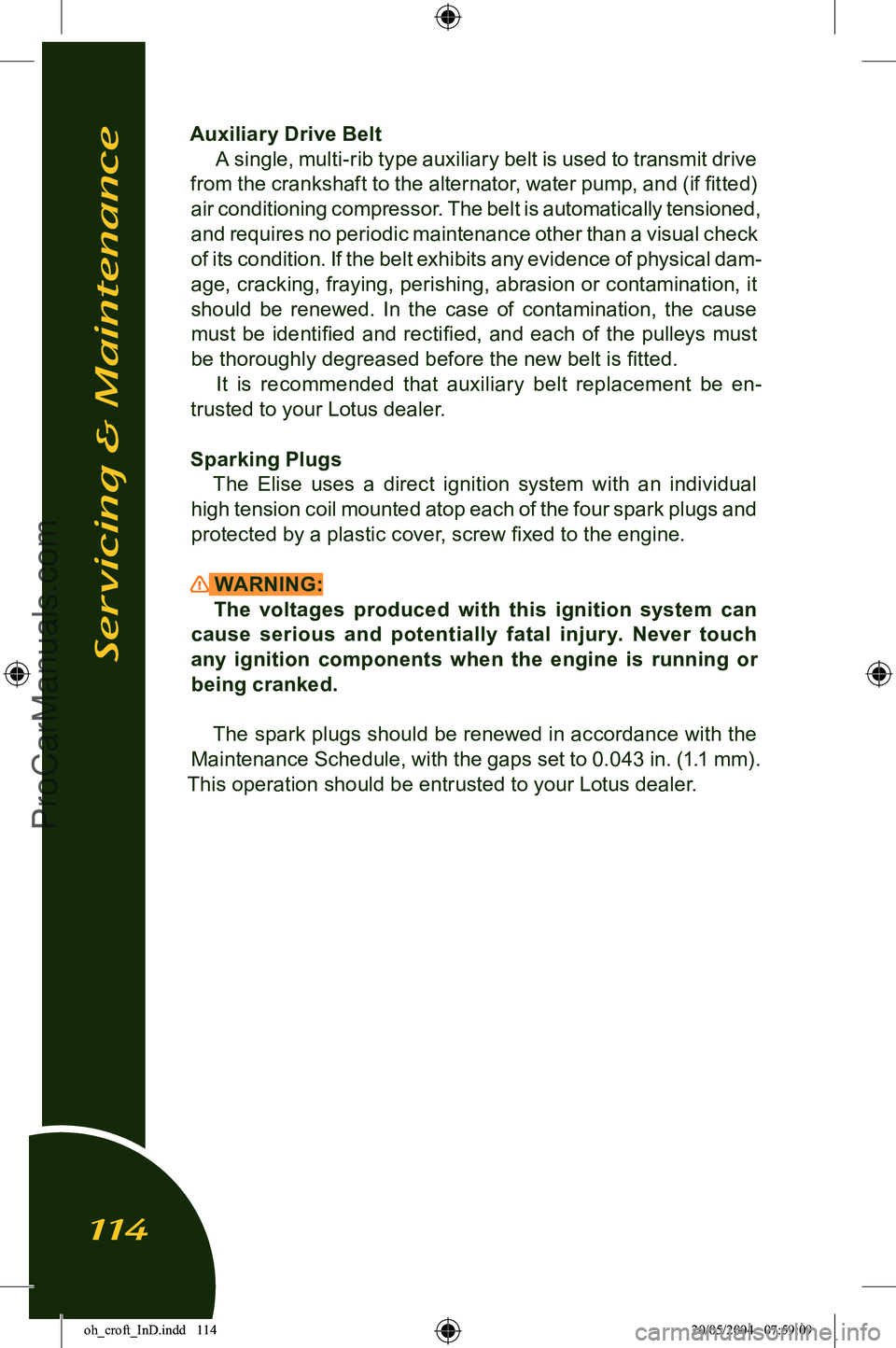
Auxiliary Drive BeltA single, multi-rib type auxiliary belt is used to transmit drive
from the crankshaft to the alternator, water pump, and (if fitted)
air conditioning compressor. The belt is automatically tensioned,
and requires no periodic maintenance other than a visual check of its condition. If the belt exhibits any evidence of physical dam
-
age, cracking, fraying, perishing, abrasion or contamination, it
should be renewed. In the case of contamination, the cause
must be identified and rectified, and each of the pulleys must be thoroughly degreased before the new belt is fitted. It is recommended that auxiliary belt replacement be en
-
trusted to your Lotus dealer.
Sparking Plugs The Elise uses a direct ignition system with an individual
high tension coil mounted atop each of the four spark plugs and protected by a plastic cover, screw fixed to the engine.
WARNING: The voltages produced with this ignition system can
cause serious and potentially fatal injur y. Never touch
any ignition components when the engine is running or being cranked.
The spark plugs should be renewed in accordance with the
Maintenance Schedule, with the gaps set to 0.043 in. (1.1 mm).
This operation should be entrusted to your Lotus dealer.
Servicing & Maintenance
114
oh_croft_InD.indd 11420/05/2004 07:59:09ProCarManuals.com
Page 117 of 205
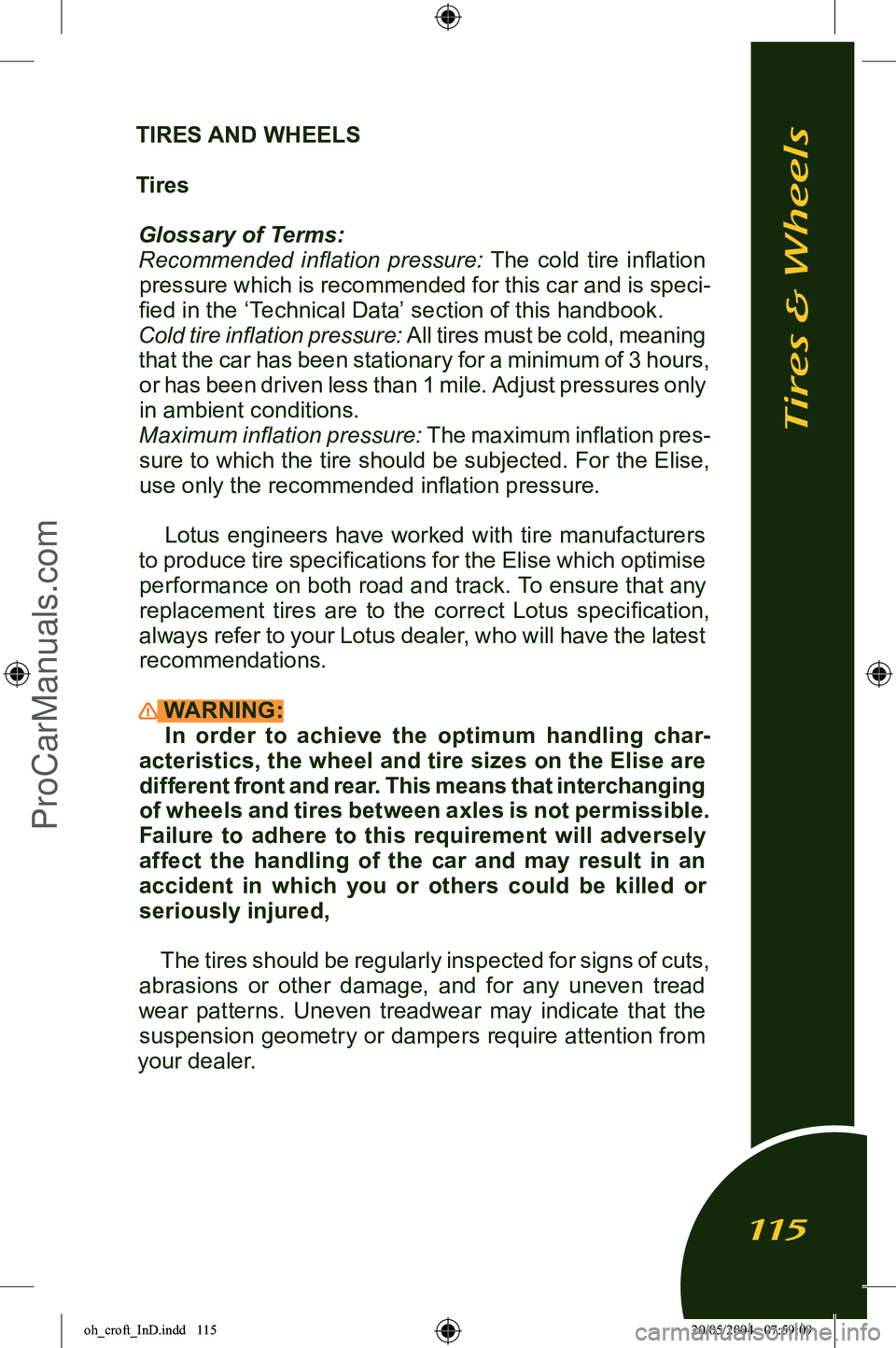
TIRES AND WHEELS
TiresGlossary of Terms:Recommended inflation pressure: The cold tire inflation pressure which is recommended for this car and is speci
-
fied in the ‘Technical Data’ section of this handbook.
Cold tire inflation pressure: All tires must be cold, meaning
that the car has been stationary for a minimum of 3 hours, or has been driven less than 1 mile. Adjust pressures only
in ambient conditions.
Maximum inflation pressure: The maximum inflation pres
-
sure to which the tire should be subjected. For the Elise,
use only the recommended inflation pressure.
Lotus engineers have worked with tire manufacturers
to produce tire specifications for the Elise which optimise performance on both road and track. To ensure that any
replacement tires are to the correct Lotus specification,
always refer to your Lotus dealer, who will have the latest recommendations.
WARNING: In order to achieve the optimum handling char
-
acteristics, the wheel and tire sizes on the Elise are different front and rear. This means that interchanging
of wheels and tires between axles is not permissible.
Failure to adhere to this requirement will adversely affect the handling of the car and may result in an
accident in which you or others could be killed or seriously injured,
The tires should be regularly inspected for signs of cuts,
abrasions or other damage, and for any uneven tread
wear patterns. Uneven treadwear may indicate that the suspension geometry or dampers require attention from
your dealer.
Tires & Wheels
115
oh_croft_InD.indd 11520/05/2004 07:59:09ProCarManuals.com
Page 118 of 205
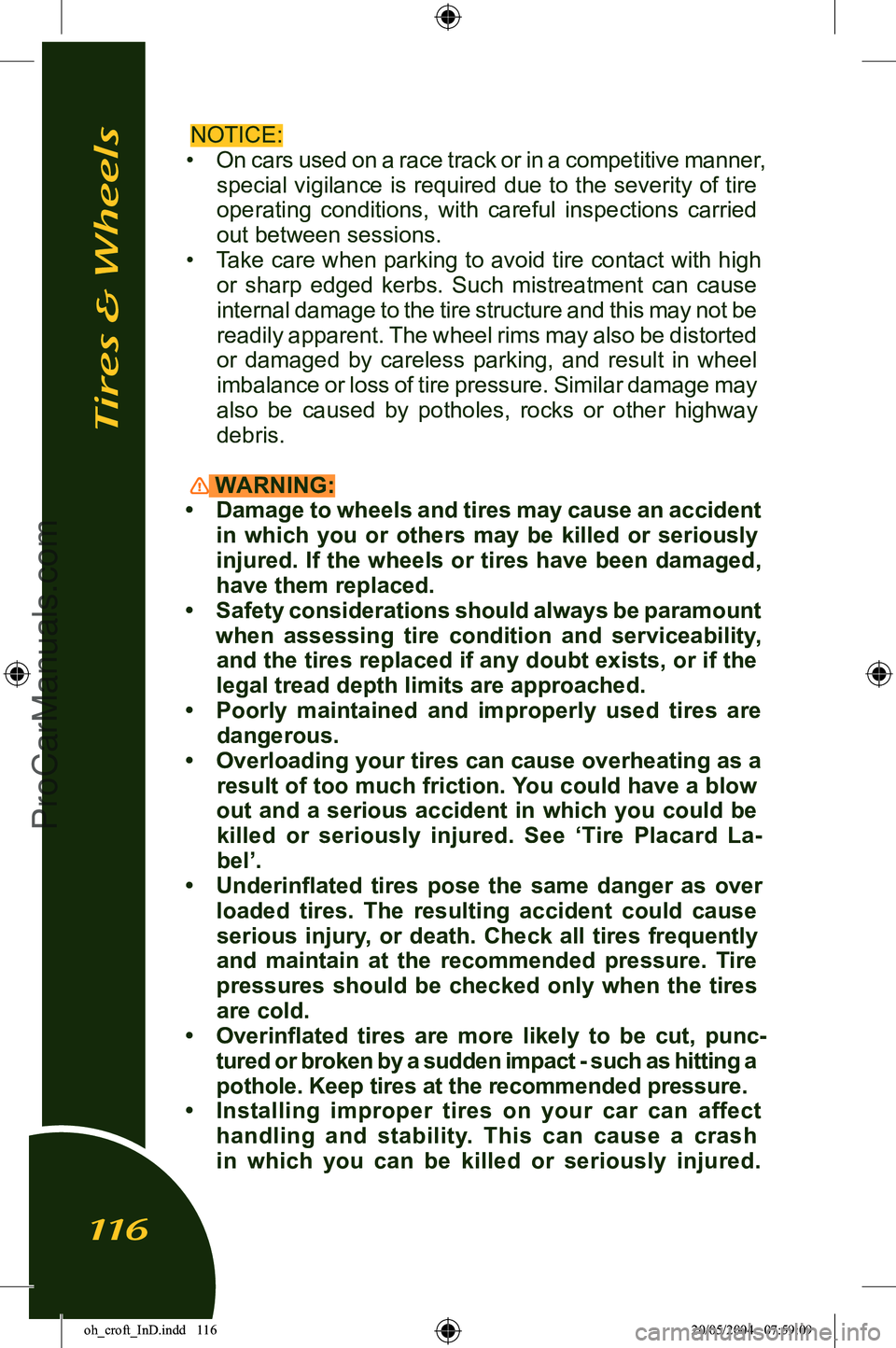
NOTICE:
• On cars used on a race track or in a competitive manner,
special vigilance is required due to the severity of tire operating conditions, with careful inspections carried
out between sessions.
• Take care when parking to avoid tire contact with high
or sharp edged kerbs. Such mistreatment can cause
internal damage to the tire structure and this may not be readily apparent. The wheel rims may also be distorted or damaged by careless parking, and result in wheel
imbalance or loss of tire pressure. Similar damage may also be caused by potholes, rocks or other highway
debris.
WARNING:
• Damage to wheels and tires may cause an accident in which you or others may be killed or seriously
injured. If the wheels or tires have been damaged,
have them replaced.
• Safety considerations should always be paramount when assessing tire condition and serviceability, and the tires replaced if any doubt exists, or if the
legal tread depth limits are approached.
• Poorly maintained and improperly used tires are dangerous.
• Overloading your tires can cause overheating as a result of too much friction. You could have a blow
out and a serious accident in which you could be killed or seriously injured. See ‘Tire Placard La
-
bel’.
• Underinflated tires pose the same danger as over loaded tires. The resulting accident could cause serious injury, or death. Check all tires frequently
and maintain at the recommended pressure. Tire
pressures should be checked only when the tires
are cold.
• Overinflated tires are more likely to be cut, punc- tured or broken by a sudden impact - such as hitting a pothole. Keep tires at the recommended pressure.
• Installing improper tires on your car can affect handling and stability. This can cause a crash
in which you can be killed or seriously injured.
Tires & Wheels
116
oh_croft_InD.indd 11620/05/2004 07:59:09ProCarManuals.com
Page 119 of 205

Always use the size and type of tires recommended
in this handbook.
• Using incorrect tires or tires which are excessively worn or improperly inflated can cause a crash in
which you can be killed or seriously injured.
• Please note your car is not fitted with a low tire pressure tell tale lamp so it is especially important
that you regularly check the tire pressures.
When driving on wet roads, surface water is squeezed
out from between the tire and road. However excessive
speed or water depth can overwhelm the water clearing capability of the tread and lead to a condition called 'aq
-
uaplaning' or ‘hydroplaning’, where the tire rides on a film of water and provides little or no grip on the road surface,
leading to a loss of control. This condition is more likely
to occur with worn tires having little depth of tread, or with incorrect tire pressures. Drivers should keep a vigilant check on tire wear and condition, and moderate their
speed in adverse weather conditions.
Tire Care Wear indicators are moulded into the bottom of the
tread grooves at intervals around the tire, indicated by small pointers on the outer tread blocks. The tires should
be replaced before being worn to this minimum legal
tread depth. The cold tire pressures should be checked every week,
or every 1,000 miles (1,700 km), whichever is the sooner,
and corrections made as necessary. See ‘Technical Data’
at the back of the handbook for tire pressures. For track
use, tire condition and pressures should be checked be
-
fore each run. Under-inflation will cause excessive wear, rapid deterioration of the tire sidewalls and heavy steering,
whereas over-inflation results in a hard ride and increased susceptibility to tire damage. Both conditions will cause a degradation in the handling qualities. It is important that the tire pressures are adjusted only
when the Tires are cold (when the car has been standing for a minimum of 3 hours, or driven less than 1 mile), as the pressures may increase by 0.3 - 0.5 bar (4 - 8 lb/in²)
when the Tires are warmed to normal running temperature.
Tires & Wheels
117
oh_croft_InD.indd 11720/05/2004 07:59:09ProCarManuals.com
Page 120 of 205

Use a good quality proprietary tire pressure gauge and always replace the tire valve dust cap to prevent the
ingress of dirt and moisture into the valve, which could cause leakage. Many fuel filling stations provide tire inflation facilities,
which specific usage instructions should be carefully fol
-
lowed. For tire pressure information, refer to ‘Technical
Data’ or the Certification Label on the driver’s door jamb
(see page 121).
Replacement Tires When replacing tires, refer to the ‘Technical Data’ sec
-
tion in this handbook, or consult your dealer to check the current Lotus specification and recommendations. Do not
use tires which differ from these specifications.
WARNING: Note that some tread patterns are directional, so
that the tire must be fitted onto the wheel with regard
to which side of the car the wheel is to be used. In
these cases, a direction of rotation arrow is included in the tire sidewall markings.
When balancing the wheel and tire assemblies, the
wheels should be located by the centre spigot hole - NOT by the wheel bolt holes. In order to maintain the correct
ohs115b
Direction of rotation arrow
Tires & Wheels
118
oh_croft_InD.indd 11820/05/2004 07:59:10ProCarManuals.com